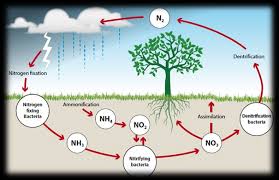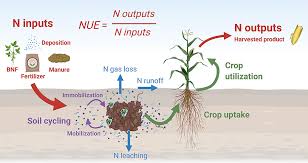The growth of all organisms depends on the availability of mineral nutrients, and none is more important than nitrogen, which is required in large amounts as an essential component of proteins, nucleic acids and other cellular constituents.
There is an abundant supply of nitrogen in the earth’s atmosphere – nearly 79% in the form of N₂ gas. However, N₂ is unavailable for use by most organisms because there is a triple bond between the two nitrogen atoms, making the molecule almost inert.
In order for nitrogen to be used for growth it must be “fixed” (combined) in the form of ammonium (NH₄⁺) or nitrate (NO₃⁻) ions. The weathering of rocks releases these ions so slowly that it has a negligible effect on the availability of fixed nitrogen.
So, nitrogen is often the limiting factor for growth and biomass production in all environments where there is suitable climate and availability of water to support life.
Microorganisms have a central role in almost all aspects of nitrogen availability and thus for life support on earth: some bacteria can convert N₂ into ammonia by the process termed nitrogen fixation; these bacteria are either free-living or form symbiotic associations with plants or other organisms (e.g. termites, protozoa).
Other bacteria bring about transformations of ammonia to nitrate, and of nitrate to N₂ or other nitrogen gases. Many bacteria and fungi degrade organic matter, releasing fixed nitrogen for reuse by other organisms.
All these processes contribute to the nitrogen cycle.
Read Also: How to Grow, Use and Care for Whitetinge Sedge Grass (Carex albicans)
Definition and Importance of Nitrogen Fixation in Agricultural Systems

Nitrogen fixation is the natural process, either biological or abiotic, by which nitrogen (N₂) in the atmosphere is converted into ammonia (NH₃). This process is essential for life because fixed nitrogen is required to biosynthesize the basic building blocks of life, e.g. nucleotides for DNA and RNA and amino acids for proteins. Nitrogen fixation also refers to other biological conversions of nitrogen, such as its conversion to nitrogen dioxide.
Microorganisms that fix nitrogen are bacteria called diazotrophs. Some higher plants, and some animals (termites), have formed associations (symbioses) with diazotrophs.
Nitrogen fixation also occurs as a result of non-biological processes. These include lightning, the industrial Haber-Bosch Process, and combustion. Biological nitrogen fixation was discovered by the German agronomist Hermann Hellriegel and Dutch microbiologist Martinus Beijerinck.
Biological Nitrogen Fixation and Its Role in Crop Production
Biological nitrogen fixation (BNF) occurs when atmospheric nitrogen is converted to ammonia by an enzyme called nitrogenase. The reaction for BNF is:
N₂ + 8 H⁺ + 8 e⁻ → 2 NH₃ + H₂
The process is coupled to the hydrolysis of 16 equivalents of ATP and is accompanied by the co-formation of one molecule of H₂.
In free-living diazotrophs, the nitrogenase-generated ammonium is assimilated into glutamate through the glutamine synthetase/glutamate synthase pathway.
Enzymes responsible for nitrogenase action are very susceptible to destruction by oxygen. (In fact, many bacteria cease production of the enzyme in the presence of oxygen).
Many nitrogen-fixing organisms exist only in anaerobic conditions, respiring to draw down oxygen levels, or binding the oxygen with a protein such as Leghemoglobin.
Key Nitrogen-Fixing Microorganisms (Diazotrophs) in Agriculture
i. Cyanobacteria
ii. Azotobacteraceae
iii. Rhizobia
iv. Frankia
Nitrogen Fixation by Rhizobia and Frankia in Leguminous Crops
Rhizobia are Gram-negative with the ability to establish a N₂-fixing symbiosis on legume roots and on the stems of some aquatic legumes. During this interaction, bacteroids, as rhizobia are called in the symbiotic state, are contained in intracellular compartments within a specialized organ, the nodule, where they fix N₂.
Similarly, Frankia, Gram-positive soil bacteria, induce the formation of nitrogen-fixing nodules in actinorhizal plants.
Read Also: How to Grow, Use and Care for Whitegrass (Leersia virginica)
Role of Cyanobacteria in Nitrogen Fixation Across Ecosystems

Cyanobacteria inhabit nearly all illuminated environments on Earth and play key roles in the carbon and nitrogen cycle of the biosphere. In general, cyanobacteria are able to utilize a variety of inorganic and organic sources of combined nitrogen, like nitrate, nitrite, ammonium, urea, or some amino acids.
Several cyanobacterial strains are also capable of diazotrophic growth. Genome sequencing has provided a large amount of information on the genetic basis of nitrogen metabolism and its control in different cyanobacteria.
Comparative genomics, together with functional studies, has led to a significant advance in this field over the past years. 2-Oxoglutarate has turned out to be the central signaling molecule reflecting the carbon/nitrogen balance of cyanobacteria.
Central players of nitrogen control are the global transcriptional factor NtcA, which controls the expression of many genes involved in nitrogen metabolism, as well as the PII signaling protein, which fine-tunes cellular activities in response to changing C/N conditions.
These two proteins are sensors of the cellular 2-oxoglutarate level and have been conserved in all cyanobacteria. In contrast, the adaptation to nitrogen starvation involves heterogeneous responses in different strains.
Nitrogen fixation by cyanobacteria in coral reefs can fix twice the amount of nitrogen than on land–around 1.8 kg of nitrogen is fixed per hectare per day.
Symbiotic Nitrogen Fixation and Its Agricultural Benefits
1. Legume Symbioses with Rhizobium
The most familiar examples of nitrogen-fixing symbioses are the root nodules of legumes (peas, beans, clover, etc.).
Part of a clover root system bearing naturally occurring nodules of Rhizobium. Each nodule is about 2–3 mm long.
Clover root nodules at higher magnification, showing two partly crushed nodules (arrowheads) with pink-coloured contents. This colour is caused by the presence of the pigment leghaemoglobin – a unique metabolite of this type of symbiosis.
Leghaemoglobin is found only in the nodules and is not produced by either the bacterium or the plant when grown alone.
In these leguminous associations the bacteria usually are Rhizobium species, but the root nodules of soybeans, chickpea and some other legumes are formed by small-celled rhizobia termed Bradyrhizobium.
Nodules on some tropical leguminous plants are formed by yet other genera. In all cases the bacteria “invade” the plant and cause the formation of a nodule by inducing localised proliferation of the plant host cells.
Yet the bacteria always remain separated from the host cytoplasm by being enclosed in a membrane a necessary feature in symbioses (see the image below).
Part of a crushed root nodule of a pea plant, showing four root cells containing colonies of Rhizobium. The nuclei (n) of two root cells are shown; cw indicates the cell wall that separates two plant cells.
Although it cannot be seen clearly in this image, the bacteria occur in clusters which are enclosed in membranes, separating them from the cytoplasm of the plant cells.
In nodules where nitrogen-fixation is occurring, the plant tissues contain the oxygen-scavenging molecule, leghaemoglobin (serving the same function as the oxygen-carrying haemoglobin in blood).
The function of this molecule in nodules is to reduce the amount of free oxygen, and thereby to protect the nitrogen-fixing enzyme nitrogenase, which is irreversibly inactivated by oxygen.
2. Symbiotic Associations with Frankia in Woody Plants
Frankia is a genus of the bacterial group termed actinomycetes – filamentous bacteria that are noted for their production of air-borne spores. Included in this group are the common soil-dwelling Streptomyces species which produce many of the antibiotics used in medicine.
Frankia species are slow-growing in culture, and require specialised media, suggesting that they are specialised symbionts.
They form nitrogen-fixing root nodules (sometimes called actinorhizae) with several woody plants of different families, such as alder (Alnus species), sea buckthorn (Hippophae rhamnoides, which is common in sand-dune environments) and Casuarina (a Mediterranean tree genus).
Alder and the other woody hosts of Frankia are typical pioneer species that invade nutrient-poor soils. These plants probably benefit from the nitrogen-fixing association, while supplying the bacterial symbiont with photosynthetic products.
3. Cyanobacterial Symbiosis with Non-Legume Plants
The photosynthetic cyanobacteria often live as free-living organisms in pioneer habitats such as desert soils or as symbionts with lichens in other pioneer habitats. They also form symbiotic associations with other organisms such as the water fern Azolla, and cycads.
The association with Azolla, where cyanobacteria (Anabaena azollae) are harboured in the leaves, has sometimes been shown to be important for nitrogen inputs in rice paddies, especially if the fern is allowed to grow and then ploughed into the soil to release nitrogen before the rice crop is sown.
A symbiotic association of cyanobacteria with cycads is shown below. The first image shows a pot-grown plant. The second image shows a close-up of the soil surface in this pot. Short, club-shaped, branching roots have grown into the aerial environment. These aerial roots contain a nitrogen-fixing cyanobacterial symbiont.
In addition to these intimate and specialised symbiotic associations, there are several free-living nitrogen-fixing bacteria that grow in close association with plants. For example, Azospirillum species have been shown to fix nitrogen when growing in the root zone (rhizosphere) of tropical grasses, and even of maize plants in field conditions.
Similarly, Azotobacter species can fix nitrogen in the rhizosphere of several plants. In both cases the bacteria grow at the expense of sugars and other nutrients that leak from the roots.
However, these bacteria can make only a small contribution to the nitrogen nutrition of the plant, because nitrogen-fixation is an energy-expensive process, and large amounts of organic nutrients are not continuously available to microbes in the rhizosphere.
This limitation may not apply to the bacteria that live in root nodules or other intimate symbiotic associations with plants. It has been estimated that nitrogen fixation in the nodules of clover roots or other leguminous plants may consume as much as 20% of the total photosynthate.
Do you have any questions, suggestions, or contributions? If so, please feel free to use the comment box below to share your thoughts. We also encourage you to kindly share this information with others who might benefit from it. Since we can’t reach everyone at once, we truly appreciate your help in spreading the word. Thank you so much for your support and for sharing!

